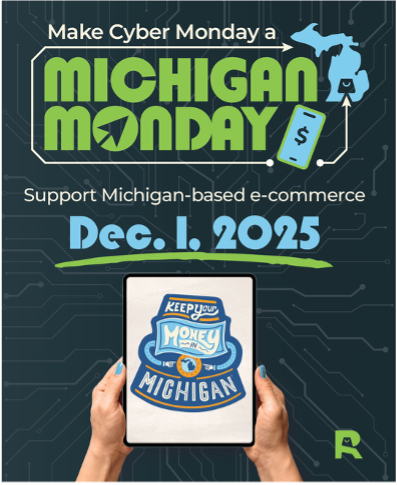Campaigns go stale fast. Here are some ideas to keep content fresh
By JENNIFER ROOK
Oscar Wilde once said that you never get a second chance to make a first impression. If only he knew how the word, “impression” would take on a whole new meaning many years later.
These days, the common marketing practice known as the “Rule of 7,” meaning that a potential customer needs to see a message at least 7 times before it leaves an impression and inspires action. Some would argue that number is now roughly 11 times or even double that.
“If you think about all of the digital campaigns, otherwise known as content, running out there following this benchmark, the vast amount of information slamming consumers is overwhelming,” says Katie Saglimbene, president of Lansing-based Elevate Marketing. “Yes, there is a lot of noise and that’s not going to change. But if you focus your efforts and resist the urge to try and reach everyone, you can attract quality customers.”
There are thousands upon thousands of articles published daily about how to find the right combination of content. Humans are fickle, points out Saglimbene. What worked one day may fall flat the next. So, how do you know if what you have out there is working? And if something isn’t, how do you know when to make a change?
Saglimbene offers five tips to keep in mind when evaluating the effectiveness of your digital campaign.
1. Keep the tone of your campaigns consistent with your brand voice
Saglimbene says this step is often overlooked for the sake of getting an appealing offer in front of a potential customer. However, if your message and brand voice do not align, the message goes stale very quickly.
“Your brand voice must reflect your core values as a business,” said Saglimbene. “Think of your brand as a person, with unique traits, characteristics, and sense of style. If you try to mirror someone else’s brand voice, it won’t sound authentic. This will cause your message to fall flat with potential customers.”
Once you determine your brand voice and align it with your products and services, stay committed. Many businesses believe that they must alter their voice to attract customers, when actually the opposite is true.
“You can’t be everything to everyone, so don’t,” said Saglimbene. “Customers that like your particular brand persona, product offering, and services will be attracted to you. This is what you want because these customers will be the most loyal and your greatest fans.”
 2. Map out your customer’s path to your business
2. Map out your customer’s path to your business
This builds upon the first point. In thinking about your brand voice in the form of a person, Saglimbene advises thinking about how your brand person greets potential customers and how that person presents themselves.
“Envision your brand persona meeting a potential customer seven times during their journey to do business with you,” said Saglimbene. “Map out how this person first says ‘hello.’ Think about what you want to communicate, how you want to say it, and how you want it delivered.”
For example, say you owned XYZ landscape and you identified your brand persona to be to-the-point, easy-going, and female. Your first initial “impression” may be in the form of an article entitled, “Five Easy Plants that Add Color to a Window Box Fast.” You can target young females and do a paid content piece on Facebook with an Instagram story mix. You can also create quick video montages and TikTok stories. You can also target three or four female influencers and run paid content on top gardening blogs/vlogs.
Have a lot of content already? This leads to the next point.
3. Squeeze as much MILEAGE out of one piece of content
Many businesses believe that they have to turn into original content machines, forever trying to come up with the next big idea just to stand out.
“Yes, originality is always favored, yet sometimes originality comes in the form of repurposing what you’ve already created,” said Saglimbene. “Taking this approach enables you to present your ideas in different ways, drives your message home, and keeps you committed to your brand voice.”
Have a six-page white paper? Think about creating an abstract to go along with it or break it up into six smaller articles that link to the white paper. Create a series of Twitter posts or a brief how-to video.
Saglimbene suggest taking different pieces of content and testing to see what appeals to your audience.
“Nowadays, there is room for experimentation,” said Saglimbene. “You can try out different messages for little to no cost and track what lands with potential customers.”
If you’ve exhausted every angle, refresh the piece, add a new call-to-action and roll it back out.
“Sharing a ‘new and improved’ version of your content will not work against you,” said Saglimbene. “Consumer package goods companies do it all of the time.”
4. Don’t overcommit to one medium
This harkens back to the first point. This was a common best practice for a long time – committing to one medium like Facebook or Instagram and putting a lot of effort to develop a presence. Many believed that if you build it, they will come.
“You should always evaluate if your audience still values the medium as much as you do,” said Saglimbene. “Poll your shoppers. Watch how many open your emails. Track comments on Facebook. If you start tracking, you can start to identify patterns. If you want to try something new, say a podcast, let your customers know.”
Saglimbene advises giving new mediums or new campaigns at least three months for a message to take hold. The latest research states that advertisers should give new mediums at least six months.
“Give a new medium a chance to work and determine how you are going to evaluate if it’s working or not before you start,” said Saglimbene. “Yes, generating sales is the end goal but also determine what else is important, like word-of-mouth promotions or establishing a good dialogue with customers.”
5. Close your feedback loop
This is an important point to drive home because it’s tempting for business owners to launch a number of digital promotions hoping to catch as many fish as possible. Saglimbene warns that doing this gets costly fast and may not be an effective strategy in the long term.
“As you plan a campaign always remember to close your feedback loop,” said Saglimbene. “This comes in the form of a ‘call-to-action.’ What do you want the customer to do once they see your message? If you leave it open-ended, chances are that nothing will come of it.”
Saglimbene says that not all content needs to end with a “buy now” link. Depending on the medium or the purpose of the content, sometimes this means providing a form fill or a link to more information.
“Determine what you want to accomplish with your content, examine the touch points, and identify the actions you want customers to take at each touch point,” said Saglimbene. “Implement one or two digital campaigns and examine what happens along the way. Monitoring a customer’s journey from beginning to end will really help you in understanding what modifications you need to make along the way. This is the key to keeping campaigns from going stale.”





